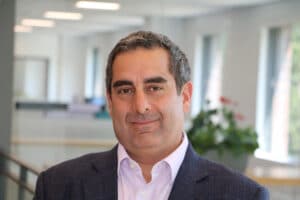Joubin Hassanein
President, Daniel O’Connell’s Sons
Age: 50
Industry experience: 27 years
Huge and complex construction projects have been part of Joubin Hassanein’s daily routine throughout his 27-year career in the industry. As a construction manager for Modern Continental and Jay Cashman Inc. in the 1990s, Hassanein was responsible for overseeing an innovative construction technique used to install loop ramps for the Central Artery Tunnel and Zakim Bridge project. Previously an executive with Boston-based Shawmut Design and Construction, Hassanein was recently named president of Holyoke-based Daniel O’Connell’s Sons. The 141-year-old firm’s current work includes a $106 million sewer upgrade project in Springfield, a $70 million athletic district redevelopment at the University of Connecticut and a $37 million rehabilitation of Logan International Airport’s runway 9-27.
Q: How much disruption to supply chains and cost escalation of materials have you seen in 2020?
A: The supply chain uncertainty is the biggest challenge. For the most part, the industry has been coping really well. What’s happening is as COVID is moving from just metro areas to rural, the factories are being impacted. So, you get lead times from subcontractors at the same time you start a project, but until you actually put the order in you don’t know you have a problem. It’s so dynamic. Prices have stayed pretty consistent. One material that’s been impacted has been brickwork. A number of factories have shut down during the COVID era. One factory shuts down, then everybody switches to ones that are operating, so there’s a big backlog.
Q: What were your responsibilities on the Central Artery Tunnel project?
A: That was over 12 or 13 years, and a very early part of my career. I was charged with learning as much as you can about a specific type of bridge: segmental bridges. Nobody in our company had any expertise in it, and quickly I became the person who had to figure it out and be in charge of it. The one I was working on was around the Boston Sand and Gravel loop ramps, and the back span of the cable-stayed bridge. It’s cast remotely in a precast facility in little segments. You assemble them, and after the fact they’re pulled together through post tensioning.
Q: What are the growth opportunities for Daniel O’Connell’s Sons?
A: At our core, we’re builders. The amount of talent and construction know-how is remarkable. We can add a tremendous amount of value to clients, both private and public, in a construction manager role, and combine this expertise with unique and unrivaled client services. We also have a tremendous portfolio of transportation and heavy civil work that we’ll continue to strengthen. A few companies struggle with that. They’re construction managers and good at managing paperwork. These guys are truly builders, and they’ve developed this over generations, and that uniquely positions us to add the most value, even in the design-build environment which is where we’ll really shine.
Q: How is the design-build construction model evolving as it gains more widespread adoption?
A: It’s actually gathered a lot of speed in our industry. Seeing institutions like the Ivy League take a step forward has emboldened a lot of the clients who are looking to close the liability gap in these projects. In a conventional project, the owner would have a contract with the contractor and a contract with the designer. The designer’s issues or problems would translate into contractors looking to be made whole. As a design-build there’s only one entity, so you’re looking for the overall outcome.
Q: How do you coordinate safety and communications with air traffic control and Massport on the Logan Airport runway 9-27 rehabilitation project?
A: We pretty much finished last week. The project was about three months, and most of it we worked 24 hours a day, seven days a week. It was great. There’s a very complex escort process. We might have 100 people on a job and 10 or 12 escorts, and as soon as you come into the gate there’s a whole background check, everybody from subcontractors to your own workforce, and the escort is in direct communication with the tower as they approach every intersection. What made this challenging is we had to deal with the COVID protocols and set up a remote location at the Hyatt Boston Harbor to clear each worker by taking their temperature and getting their vitals.
Q: How much material was required on this project?
A: It was about 95,000 tons of asphalt. For us, 1,000 or 1,500 tons is a big job. This is 95,000 tons.
Q: How does the York Street pumping station and Connecticut River crossing sewer project in Springfield upgrade the system?
A: In extreme storm events, the existing pump station gets overwhelmed and the flow will go into the Connecticut River. The new pump station has twice the capacity and also, we’ll have the existing pump station stay online to address rare flow conditions. Really, it’s the water quality of the Connecticut River that’s going to benefit the most from that. We have a new pipe that connects the new pumping station to the existing infrastructure, so they can divert some of the flow.
Hassanein’s Five Favorite New England Ski Destinations
- Stowe, Vermont
- Okemo, Vermont
- Sunday River, Maine
- Sugarloaf, Maine
- Jay Peak, Vermont




 |
| 

